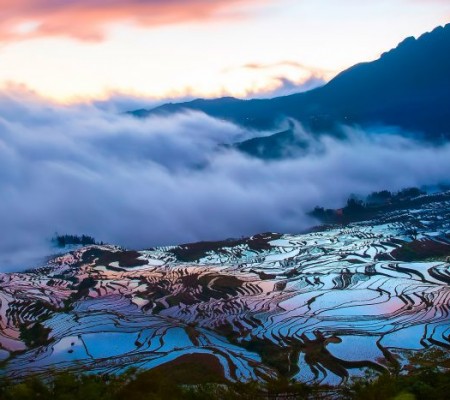
Lezuo Dance in Honghe County, Honghe
Lezuo Dance in Honghe County, Honghe
Known as “Eastern Disco,” the Lezuo Dance is a national intangible cultural heritage created jointly by the Hani and Yi ethnic groups. Its unique charm and profound cultural roots immerse viewers in a celebration of ethnic art. Below is a comprehensive exploration of this dynamic cultural treasure:
I. Historical Roots: A Millennium of Living Memory
-
Origins: The Lezuo Dance began in Azhehe Township, Di Shi Luo Meng area, as the Yi people’s “Cai Qiao Dance,” mimicking agricultural movements like harvesting buckwheat and planting rice.
-
Evolution: Over a thousand years, it blended Hani polyphonic songs and Yi three-string rhythms, forming a complete system of 12 dance steps and 2 musical sets.
-
Recognition: Designated as the “County Dance” in 2003, listed as a national intangible heritage in 2008, and earned Red River County the title “China’s Folk Art Hometown.”
II. Artistic Code: Cultural Symbols Through Movement
(1) Three Layers of Dance Language
-
Labor Epic:
-
Cai Qiao Step: Clockwise/counterclockwise “three steps forward, one back,” mimicking light buckwheat harvesting, skirts swirling like waves.
-
Nian Diao Step: Quick-paced垫steps recreating ancestors’ agility in driving away wild animals, embodying survival wisdom.
-
-
Emotional Code:
-
Foot-Kicking Dance: Men and women kick feet in rhythm, expressing love through physical interaction.
-
Back-Rubbing Dance: Dancers rub backs to symbolize community cooperation, reflecting the philosophy of “many hands make light work.”
-
-
Nature’s Ode:
-
You Diao: Bodies sway like mountain streams, embodying “harmony between humans and nature.”
-
Snail Touch: Bending and reaching movements, inspired by terraced field labor, express the Hani’s “forest-village-terrace-water” ecosystem.
-
(2) Sonic Spectacle
-
Instrument Symphony: Flutes soar like eagles, bawu (bamboo mouth organ) trills like springs, three-string instruments pulse like Earth’s heartbeat, with grass leaves adding spontaneous harmonies.
-
Vocal Patterns:
-
Xun Ban Tune: Flute-led call-and-response between men and women, akin to the Book of Songs’s “Guanguan Zhujiu.”
-
Ah Li Tune: Lullaby-like solo sung under moonlight, called the “Hani Night Song.”
-
Boast and Scold Tunes: Playful duets during festivals, using humor to ease life’s pressures.
-
III. Cultural Arena: From Fields to Global Stages
(1) Festival Frenzy
-
October Festival: At Samaba’s ten-thousand-mu terraces, villagers in indigo Hani attire dance in hundreds of circles under moonlight, creating a “dance in the painting” spectacle.
-
Torch Festival: In Yi villages, blazing torches light the night as Lezuo Dance intertwines with torch processions, a “tribute to fire.”
-
Opening the Rice Fields: Spring plowing rituals at Jiatun terraces, where tourists join in planting, fishing, and dancing to celebrate “early spring diligence.”
(2) International Resonance
-
2006 Netherlands Performance: Dutch dancers praised it as “Eastern modern dance with postmodern deconstructivist spirit.”
-
2019 Lincoln Center Showcase: Audience marveled at its improvisational interactivity, exclaiming, “Dance can be so free!”
-
2024 May Day Mass Dance: Attracted over 100 visitors from Zhejiang and Guangdong, with one noting, “This isn’t a performance—it’s living culture!”
IV. Immersive Cultural Journey
(1) Time-Travel Itinerary
-
Morning: Visit Zuofu Village’s mushroom houses, learn “Cai Qiao Step” from master Li Apang, and craft a three-string instrument.
-
Afternoon: Stroll through Mabang Ancient Town, listen to Nian Diao stories at Dongmen Tower, and trace horse hoof prints on ancient stone paths.
-
Dusk: Capture the “golden terrace sunset” and Lezuo Dance at Samaba’s viewpoint.
-
Night: Join the mass dance on Lotus Avenue, led by Yi elders, to feel the rhythm of “three-step string.”
(2) Cultural Decoding Tips
-
Costume Code: Hani indigo shirts feature “terrace patterns,” Yi black vests have “flame motifs,” and silver bells on dancers create a dual audio-visual feast.
-
Food Pairing: At long-table feasts, savor Hani bean paste and sour bamboo shoots with wine for an enhanced experience.
-
Photography Tips: Use slow shutter speeds for dynamic skirt swirls; bring fill lights at night to capture fire-and-dance interplay.
V. Preservation and Modern Transformation
-
Education: Lezuo Dance incorporated into school exercises in Baohua Town, where children dance “Nian Diao Step” with youthful energy.
-
Tech Empowerment: Digital platforms in Red River County use 3D scanning and VR to let global audiences “dance virtually.”
-
Cultural Tourism: Mabang Ancient Town offers “Lezuo Dance-themed homestays,” where visitors wear ethnic attire, learn night dances, and live as “Yi people for a day.”
VI. Practical Guide
-
Best Viewing Times: April’s Opening the Rice Fields, October’s October Festival, and Lunar New Year’s Torch Festival.
-
Transport: Take a bus from Kunming South Bus Station to Red River County (5 hours), then hire a car to Azhehe Township (1.5 hours).
-
Accommodation: Yisa Ancient Town’s Mabang-themed guesthouse, with views of century-old arcades and dancing figures.
-
Souvenirs: Lezuo Dance-themed tie-dye scarves, three-string keychains, or custom bamboo flutes engraved with names.


http://www.ynich.cn/view-ml-11111-1217.html

 7 Days GolfingTour
7 Days GolfingTour
 8 Days Group Tour
8 Days Group Tour
 8 Days Yunnan Tour
8 Days Yunnan Tour
 7 Days Shangri La Hiking
7 Days Shangri La Hiking
 11 Days Yunnan Tour
11 Days Yunnan Tour
 6 Days Yuanyang Terraces
6 Days Yuanyang Terraces
 11 Days Yunnan Tour
11 Days Yunnan Tour
 8 Days South Yunnan
8 Days South Yunnan
 7 Days Tea Tour
7 Days Tea Tour
 8 Days Muslim Tour
8 Days Muslim Tour
 12 Days Self-Driving
12 Days Self-Driving
 4 Days Haba Climbing
4 Days Haba Climbing
 Tiger Leaping Gorge
Tiger Leaping Gorge
 Stone Forest
Stone Forest
 Yunnan-Tibet
Yunnan-Tibet
 Hani Rice Terraces
Hani Rice Terraces
 Kunming
Kunming
 Lijiang
Lijiang
 Shangri-la
Shangri-la
 Dali
Dali
 XishuangBanna
XishuangBanna
 Honghe
Honghe
 Kunming
Kunming
 Lijiang
Lijiang
 Shangri-la
Shangri-la
 Yuanyang Rice Terraces
Yuanyang Rice Terraces
 Nujiang
Nujiang
 XishuangBanna
XishuangBanna
 Spring City Golf
Spring City Golf
 Snow Mountain Golf
Snow Mountain Golf
 Stone Mountain Golf
Stone Mountain Golf















